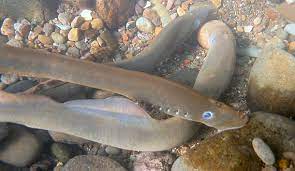Cyclostomata is a primitive Vertebrate belonging to the group Agnatha as they do not have jaw and their mouth is circular so they are known as Cyclostomes. Present-day Lamprey and Hagfish we see are placed under the class Cyclostomata, before Cyclostomata we have no living evidence for primitive Vertebrate, one group Ostracoderms also considered as primitive Vertebrate but they are now extinct.
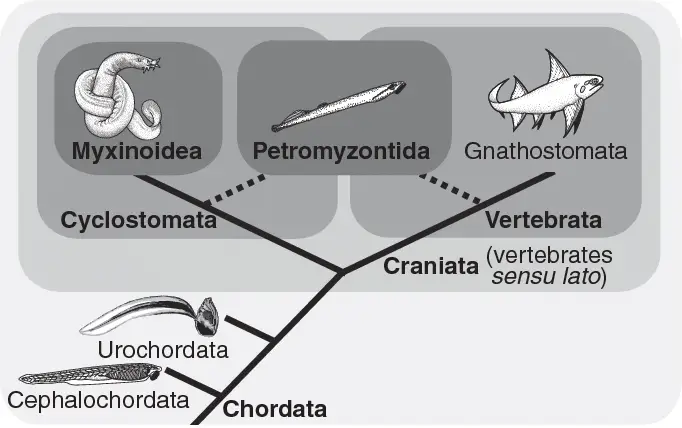
Table of Contents
General Characteristics of Class Cyclostomata:
- The mouth is not supported by jaw, so we can say them jawless primitive Vertebrate. In their mouth teeth present but it is epidermal teeth, not actual teeth.
- Body is elongated and similar to eel fish in external appearance but they are not actually fish.
- No paired appendages present, fin all are unpaired, median unpaired fin is supported by cartilaginous gil rays, the tail is diphycercal.
- Body not show any exoskeleton or scales, the skin is smooth and slimy due to the secretion of mucous gland present on their skin.
- Endosketon present but no bony endosketon present, the endosketon made of cartilaginous tissues. The persistent notochord represent main axial endosketon, the notochord is covered by connective tissue sheath.
- The notochord have imperfect traces of vertebrae known as arcualia or neural arches.
- The body is divided into three parts, head, trunk and muscular post anal tail, the muscle in trunk and tail show segmentation, the muscle segments are known as myotomes, each myotomes are separated from each other by myocommas.
- The mouth maybe present ventrally (suctorial mouth in Lamprey) oray be present terminally (terminal mouth of Hagfish).
- The digestive tract is straight and complete but stomach absent, the intestine have spiral valve.
- The external gill slits are 1 to 15 pairs, the external gill slits open internally into 5 to 16 pairs of gill pouches.
- The circulatory system have two chambered heart, the blood have hemoglobin rich red blood corpuscles and white blood corpuscles, hepatic portal system present but renal portal system absent.
- The primary excretory organ may be paired mesonephric kidneys or pronephric kidneys (in some species of Hagfish).
- The brain maybe well developed (in Lamprey) or maybe poorly developed (in Hagfish), the cranial nerve are 8 to 10 pairs.
- The external gill is single and median, number of semicircular canals in internal ear 1 or 2 pairs.
- Sexes are separate in Lamprey but sexes are united in Hagfish, the gonad do not have gonoducts.
- Fertilization occur externally in the water, some species migrate to freshwater from marine water for spawn, development maybe direct or indirect with a prolonged Ammocoet larval stage.
Detailed Study On Characteristics Features of Cyclostomata
Classification of Cyclostomata:
There are around 50 living species of class Cyclostomata but the members of class Cyclostomata show very much dissimilarity. For those dissimilarities, some workers proposed them place in separate groups because the members of class Cyclostomata phylogenetically different.
The similarities present in them is due to the result of the convergent evolution but yet as they all show circular jawless mouth so we place them together in class Cyclostomata. The members of class Cyclostomata may be divided into two groups, order Petromyzontiformes, and order Myxiniformes, we will discuss all characteristics of both groups of Cyclostomata.
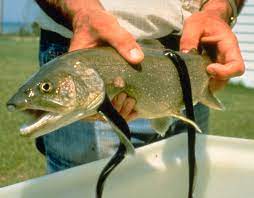
Order 1: Petromyzontiformes:
- Order Petromyzontiformes include the Lamprey, they are also known as lamper eels, lamperns or sand pride.
- The circular small mouth present ventrally at the centre of a cup shaped buccal funnel, the buccal funnel is suctorial and denticulated with conical yellowish epidermal teeth.
- Single median nostril present on the head near the lateral eyes, the nasohypophyseal sac is closed at posterior end, not connected to the pharynx.
- The seven pairs of external gill slits open internally into seven pairs gill pouches, the gill pouches again open internally into the respiratory pharynx through internal gill slits.
- The gill system is supported by cartilaginous branchial basket, the dorsal fin is strong and supported by cartilaginous fin rays.
- In internal ear two semicircular canals present, the spinal nerve have separate dorsal and ventral root.
- Members of Petromyzontiformes are available in both freshwater as well as marine water, the marine water form migrate to freshwater during spawn.
- The sexes are separate, fertilization occur externally in the water, the development is indirect, include a prolonged fish like larval stage, Ammocoet larva.
Some important examples of Order Petromyzontiformes are Lampetra, Ichthyomyzon, Entospherus, Petromyzon, around 30 species are present under this order.
Order 2: Myxiniformes:
- They are popular for producing large amount of slime on their skin, this order include the Hagfish.
- The mouth is present terminally on the head, the terminal mouth have wrinkled lip, the wrinkled lip give them a old woman like look or hag, so they are known as Hagfish.
- The terminal mouth is surrounded by 4 pairs of tentacls, teeth are very few and the mouth is not suctorial.
- The nostril present terminally, the nasohypophyseal sac open into the pharynx behind.
- The gill slits are 1 to 15 pairs and they open into 5 to 15 pairs gill sac internally.
- The dorsal fin is not stout as in Petromyzontiformes, the dorsal fin maybe absent.
- The spinal nerve have united dorsal and ventral roots, number of cranial nerve are 8 pairs.
- The internal ear have only one semicircular canals, the branchial basket is poorly developed.
- The development do not have any larval stage, development is direct and all the Hagfish are exclusively marine.

Around 15 living species present under this order, some examples of Order Myxiniformes are Paramyxine, Myxine, Eptatretus.
Detailed Study On Classification of Cyclostomata
Examples of Cyclostomata:
Petromyzon:
Petromyzon is a species under the order Petromyzontiformes, Petromyzon shows a fish-like larval stage known as Ammocoet larva. Petromyzon lives in freshwater as well as marine water but during the spawn, Petromyzon migrates to a freshwater river. The Ammocoet larva is a filter feeder, the body is transparent, the larval stage lasts for a very long time span, 4 to 7 years. After that, the Ammocoet larva becomes an adult Petromyzon.
The adult Petromyzon is an external parasite on bony fishes, the suctorial mouth helps Petromyzon to attach with the prey fish, the adult Petromyzon suck the body fluids and make a wound on the body of bony fishes. The wound sometimes leads to different types of infectious diseases and sometimes becomes fatal. So the Petromyzon population is not good for fish culture, but if we see on the positive side, Petromyzon is used as food in some regions.
Myxine:
Myxine is a Hagfish belonging to the order Myxiniformes, Myxine is only present in marine water, we can not find them in freshwater. The Myxine generally present near the sea bottom and feed on the polychaetes, they live in colonial form and form burrows in the mud or sand in the oceanic floor.
The elongated eel-like body does not have any scales, the skin is soft and pinkish, they reach a length around 50 cm, the body is divided into three parts, head, tail, and trunk. Myxine has a terminal mouth with a wrinkled lip, the wrinkled lip gives Myxine a look of an old lady or Hag, for this reason, they are known as Hagfish.
Their eyes are hidden under the skin covering but the paired tentacular sensory structure makes them able to sense in their surroundings. They are also known as slime eel because on their skin large number of mucous glands open which secret a large amount of slimy secretion. Myxine is an internal parasite on dead or injured fishes, they create pores on the body of the victim fish and feed on the flesh of the fish.
Like Petromyzon, Myxine is also a great threat for fisheries, the adult Myxine spawns in marine water, and development is direct without any larval stage.
Eptatretus:
It is also an example of Hagfish, they are abundant in the coastal areas of South Africa, New Zealand, and America, they have great resemblance with Myxine. But Eptatretus are much longer than Myxine, Eptatretus reach up to one meter in length.
Eptatretus have 6 to 15 pairs of external gill slits and the gill slits are open into the gill pouches on each side but the last external gill slit on the left side opens into the pharynx directly through the pharyngocutaneous duct.
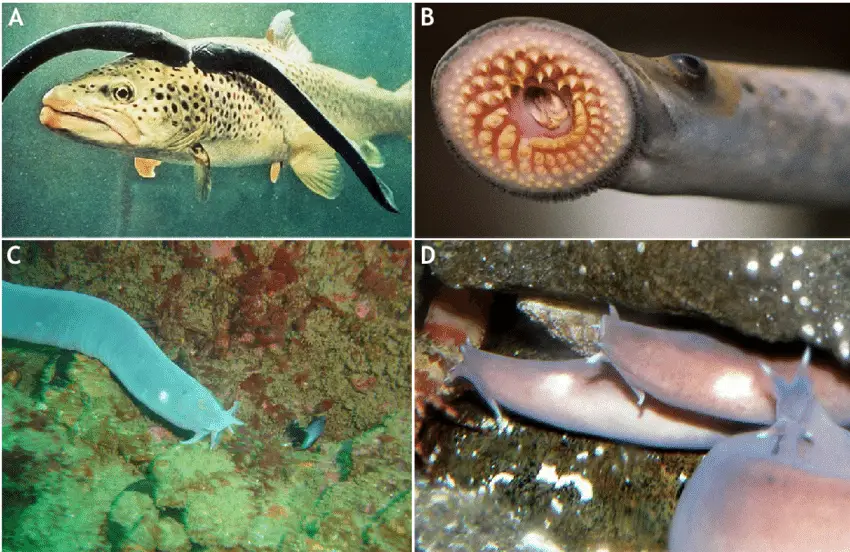
Detailed Study On Examples of Cyclostomata
Differences Between Lamprey and Hagfish:
| Lamprey | Hagfish |
| Lamprey belongs to the Petromyzontiformes order of class Cyclostomata. | Hagfish belong to Myxiniformes order of class Cyclostomata. |
| Lamprey is present in freshwater as well as in marine water but during spring the marine form migrates to the freshwater. | All the Hagfish are marine, they do not migrate to freshwater for the spawn. |
| In the life cycle of Petromyzon, a prolonged larval stage is present, the larva is known as Ammocoet larva. | In the life cycle of Hagfish, no such larval stage include, the development is direct in Hagfish. |
| The adult Petromyzon are external parasites on the bony fishes, they suck the blood of the bony fishes. | Hagfish are internal parasites on dead or injured fishes, they feed on the flesh of the fish. |
| The mouth in Petromyzon is present ventrally, the mouth has a suctorial buccal funnel which helps them to attach with the body of prey fishes. | The mouth of Hagfish is terminal and the mouth is surrounded by sensory tentacles. |
| The dorsal fin in Petromyzon is notched and has two dorsal fins, the first dorsal fin, and the second dorsal fin. | The dorsal fin in Hagfish is single continuous, in some species it remains absent. |
| The fin system in Petromyzon is very powerful because the fin rays are joined at their base with the connective tissue sheath of the notochord. | The fin system is feeble as compared to the fin system of Petromyzon. |
| On the head two functional lateral eyes are present and a pineal eye is present between the two lateral eyes. | In Hagfish the lateral eyes are not functional, they are covered by the skin, pineal eye absent. |
Detailed Study On Differences Between Lamprey and Hagfish
Affinities of Cyclostomata:
Cyclostomata have all the required fundamental features of phylum Chordata but the Ammocoet larva of Cyclostomata show very much similarity with Cephaochordata. The adult Cyclostomes lack some features which are present in their larval stage, so in adult Cyclostomes, some degenerate features are present, in adult Cyclostomes some specialized features are also present. We will list all the primitive, degenerate, specialized, and advanced features present in class Cyclostomata.
Primitive Characters present in Cyclostomata:
Class Cyclostomata show similarity with the lower Chordata, they show similarity with Cephaochordata, Ostracoderms, those similarities indicates that Cyclostomata is intermediate between the lower Chordata and modern Vertebrate.
Resemblance With Cephaochordata:
- Cephaochordata as well as Cyclostomes do not have jawed mouth, the gonad are ductless and paired appendages absent, exoskeleton absent.
- The notochord present throughout the life in Cephaochordata as well as in Cyclostomata, the notochord present throughout the length of their body.
- The lateral gill slits in large numbers, the lateral body muscle show segmentation, each segment are known as myotomes, myotomes are separated from each other by myocommas.
- The spinal cord have separate dorsal and ventral roots, in Cephaochordata first we can see development of separate dorsal and ventral roots in spinal nerve.
- Specially the Ammocoet larva of Cyclostomata show great similarity with the Cephaochordata, the Ammocoet larva is fish like and the upper lip form ridge like structure which is resembles with the oral hood of Cephaochordata.
- In Ammocoet larva the dorsal fin is continuous as in Cephaochordata.
- The endostyle in pharynx and filter feeding also similar between Cephaochordata and Ammocoet larva.
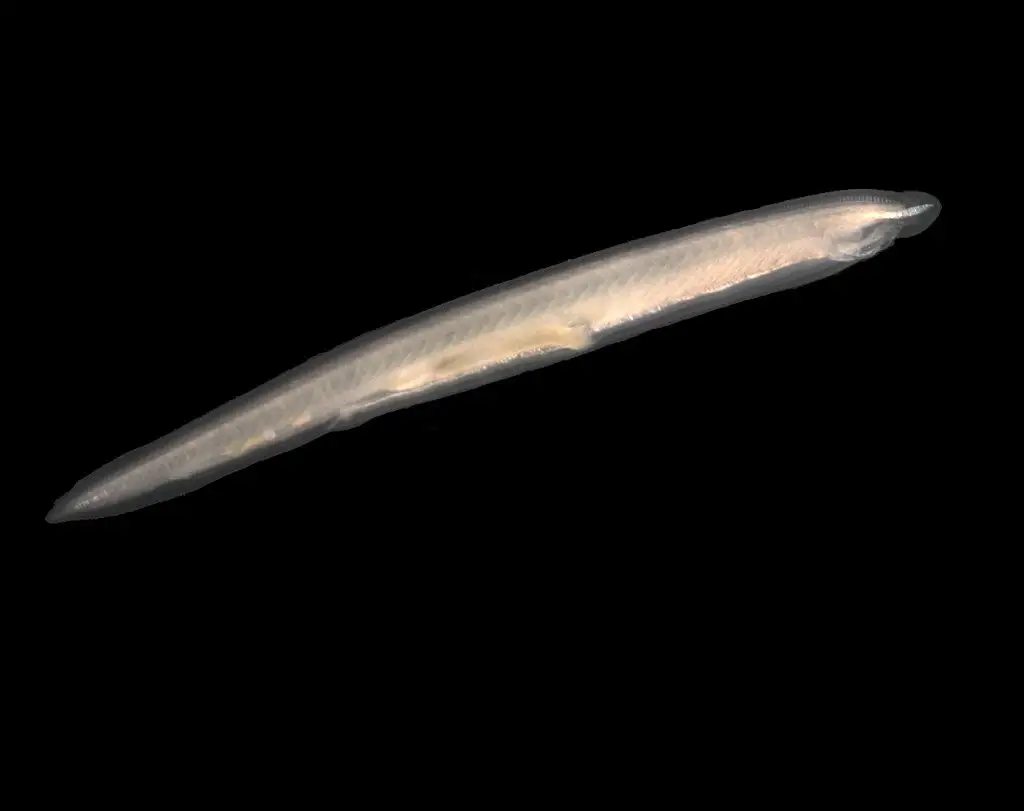
Dissimilarity of Cyclostomata with Fish:
Some species of Cyclostomata have a look of fish externally but they are not actual fish, the fundamental features present in fish are absent in Cyclostomata.
- True fishes have jawed mouth with biting actual teeth but in Cyclostomata the mouth do not have jaw and the teeth are epidermal.
- In actual fish we can see exoskeleton in the form of scale but in Cyclostomata scale absent.
- The intestine of Cyclostomata show longitudinal spiral valve but in actual fish there are no such structure, the stomach present in fish is absent in Cyclostomata.
- In fish paired appendages present in the form of paired fin, in Cyclostomata no paired appendages present all the fin are unpaired.
- External nostrils in most of the Cyclostomata are single and median but in fish the external nostrils are two.
- The heart of fish is two chambered as well as in Cyclostomata but the heart in adult Cyclostomes is tubular S shaped.
- The nerve fibres are non myelinated in Cyclostomata which are myelinated in fish, number of semicircular canals in fish is 3 pairs but in Cyclostomata 1 or 2 pairs semicircular canals present.
Affinities of Cyclostomata with Ostracoderms:
The Ostracoderm are now extinct but the study of their fossil evidence shows some important similarities with Cyclostomata, for this similarity Cyclostomata and Ostracoderms, are placed under Group Agnatha together.
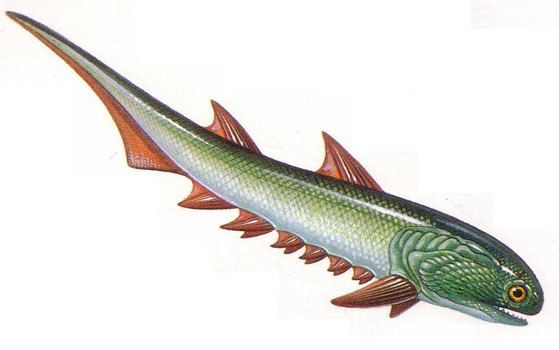
- Both Cyclostomata and Ostracoderms are jawless Vertebrate, paired appendages absent in both of them.
- The external nostrils is single in both cases, the pineal eye is observed in both cases.
- The external gill slits open into lateral gill pouches internally, internal ear have one or two semicircular canals.
Advanced Features in Cyclostomata:
The advanced features which separate the Cyclostomata from other lower Chordata are listed below:
- The well developed brain encapsulated inside the cranium, the paired eyes with internal ear, cranial nerve are well developed.
- From Cyclostomata we can see the starting of development of segmental vertebrae which present in the form of vertebral column in higher Vertebrate.
- Presence of sympathetic nervous system with separate dorsal and ventral root in spinal nerve, the integument is multilayered, both dermis and epidermis present.
- The Segmentation in lateral body muscle and E shaped myotomes separated by myocommas.
- Well developed circulatory system with muscular contractile heart, hemoglobin rich red blood corpuscles, white blood corpuscles, presence of hepatic portal system.
- Excretion occur through paired mesonephric kidneys ( in some species pronephric kidneys also present).
Specialised Features in Cyclostomata:
The adult Cyclostomes are parasitic on other marine animals, especially on bony fishes, in Cyclostomata we can see different specialized features which are due to their parasitic adaptation.
- In Petromyzon the mouth is present in a cup shaped buccal funnel, the suctorial buccal funnel and the horny teeth present on their buccal funnel help them to remain attached with the prey fish.
- The tongue have specialised teeth which helps them to remove the flesh from the body of victim fish.
- The salivary gland present in Petromyzon have anticoagulant which prevents the clotting of blood during sucking of blood from the prey fish.
- The respiratory pharynx is completely separate from the esophagus, during attachment with the victim fish the mouth of Petromyzon get engaged, so water do not enter into their mouth, then the water present in their blind sac respiratory pharynx is used for respiration.
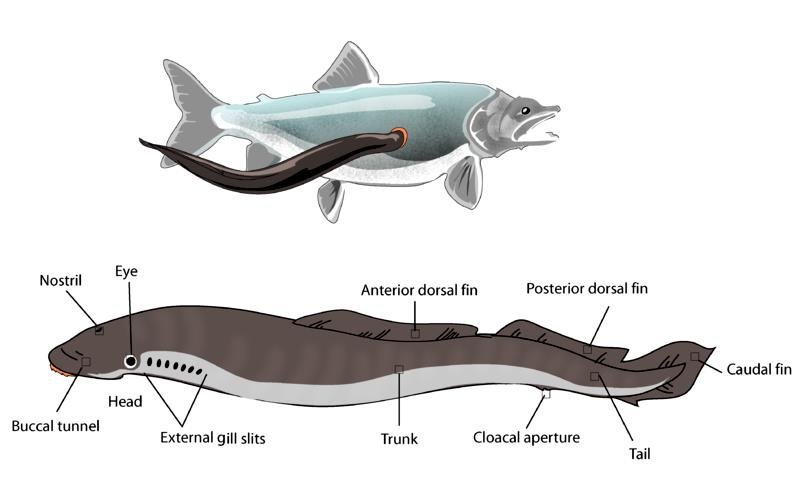
Degenerate Features in Cyclostomata:
In Ammocoet larva, Cyclostomata has some advanced features but in adults, some of the advanced features remain absent, so the larva undergoes retrogressive metamorphosis, we listed all the degenerate features of Cyclostomata.
- Ostracoderms have fish like external appearance which are similar to the modern fish but in Cyclostomata the body shape become eel shaped.
- In Ostracoderms the body is armoured by bony heavy exoskeleton, in fish the body is covered by scales but in Cyclostomata the body is not covered by any exoskeleton.
- The eye are functional in some species of Cyclostomata but in some species the eye become vestigial, the eyes are covered by thick skin covering.
- The gall bladder and bile duct present in Ammocoet larva of Cyclostomata but in adult Petromyzon gall bladder and bile duct remain absent.
Detailed Study On Affinities of Cyclostomata
Phylogeny of Cyclostomata:
Presently we place Cyclostomata with Ostracoderms under Group Agnatha because both of them lack a jawed mouth and paired appendages. The features present in Cyclostomata and Ostracoderms are more advanced than Cephaochordata but lower than modern advanced Vertebrate. The similarities between Ostracoderms and Cyclostomata indicate that the Cyclostomata evolved from the Ostracoderm.
In some research, it comes out that Gnathostomata did not evolve from the Cyclostomata because there is some evidence that proves that Gnathostomata is much more primitive than Cyclostomata.

The two orders of Cyclostomata are not phylogenetically present on the same line of evolution. It comes out from the intense study that the Petromyzontiformes and Myxiniformes have separate Phylogeny, Petromyzontiformes evolved from Cephalaspides but Myxiniformes evolved from Pteraspids, so the Cyclostomata are diphyletic in origin.
Detailed Study On Phylogeny of Cyclostomata
Reference Cyclostomata General Characteristics Features Classifications Systematic Position Affinities
Hi Everyone!!! Welcome to Imaluop. Imaluop always try to learn some new and he want to share to other people. Here we will try to learn various topics on Science, specially on Biological Sciences.
